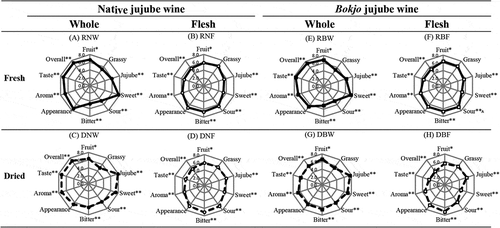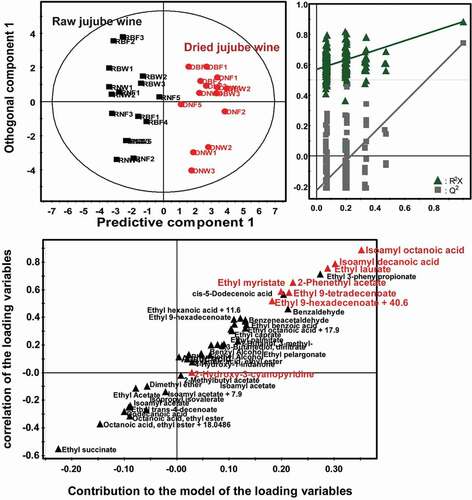ABSTRACT
Fermented jujube wine, derived from the red jujube berry, has a unique flavor, a mild and sweet taste, and high nutritional value. Among diverse varieties of jujube, Bokjo and the native variety are the most frequently cultivated varieties in Korea. The present study aimed to determine the brewing properties of jujube and to compare the characteristics of fresh and dried fruits of the native and Bokjo varieties for optimal brewing conditions for jujube wine production. We investigated the physicochemical and sensory properties, and we compared the volatile compounds in jujube wine prepared using different methods, through solid-phase microextraction (SPME) GC/MS analysis. The physicochemical properties of jujube wine depended on the drying process rather than the cultivar or the presence of seeds. Sensory properties including aroma and sweetness, which have positive effects on jujube wines, were greater in the whole dried fruit group, while negative properties including grassy aroma, sourness, and bitter taste, were high in the fresh fruit group; these observations contrast their physicochemical properties, as analyzed using dried jujube with seeds. Significant differences were observed in volatile compounds among jujube wine samples. In particular, isoamyl octanoate, isoamyl decanoate, ethyl laurate, ethyl myristate, and 2-phenethyl acetate potentially contribute to the jujube-like flavor of dried jujube wine. These results could be useful as basic data for raw material processing for jujube wine production.
Introduction
Jujube, family Rhamnaceae (Buckthom), is a small-to-medium sized drupe fruit growing in natural wild and cultivated orchards in Korea, China, Japan, and several Middle Eastern regions. Each berry is approximately 3–6 cm in diameter, with oval, oblate, and round to elongated and cylindrical morphology. Raw, fresh berries can be last 3–4 days at ambient temperature and for a couple of weeks under refrigeration condition. Completely mature jujube fruits develop wrinkled surfaces. Normally, dried berries can be stored longer for several months. The berries can also be consumed raw or further processed into juice, wine, powder, etc.[Citation1]
Jujube, fresh or dried, is a healthy fruit. The berry contains numerous essential nutrients, vitamins, and minerals. Fresh jujube contains higher levels of vitamins, especially ascorbic acid and B-complex vitamins, whereas dried jujube are rich in minerals, calcium, and iron.[Citation2,Citation3] Level of bioactive compounds such as flavonoids, polyphenols, and ascorbic acid and their antioxidant activity in jujube differ in accordance with the cultivar [Citation4–Citation7], drying method [Citation4], tissues [Citation8], and maturity stages.[Citation9] Jujube wine fermented from red jujube has a unique jujube flavor, soft and sweet taste, and high nutritional value. Some studies on jujube wine have been conducted to identify their quality characteristics.[Citation10–Citation12]
Among various varieties of jujube, Bokjo is the most frequently cultivated variety in Korea.[Citation13] A previous comparison of the characteristics of fresh and dried fruit of native jujube, also known as Yak jujube, and Bokjo jujube revealed that native variety is softer and sweeter, with higher general nutrient content, despite being smaller than Bokjo.[Citation2] The objective of the present study is to identify the brewing properties of jujube and compare the characteristics of fresh and dried fruits of native jujube and Bokjo varieties to provide useful information for wine production using jujube. Our results can guide studies on jujube wine and its development and utilization of the local variety.
Materials and methods
Raw materials
For jujube (Ziziphus jujuba Miller) sample preparation, native and Bokjo varieties were purchased as both dried and fresh fruits from Guam Farm (Gyeongsangbuk-do, Korea) and were stored at −20°C before winemaking. Fermivin (Saccharomyces cerevisiae var. cerevisiae, No. 7013, Oenobrands, France) was inoculated as a starter strain and all other reagents were above analytical grade.
Assessment of jujube wine
Jujube wines were prepared as described previously with some modifications [Citation14], and the jujubes were grouped in accordance with the cultivar (native and Bokjo), dryness (fresh and dried fruits), and presence of seeds (whole fruit and fruit flesh). presents a schematic representation of jujube wine fermentation. First, jujube was classified as native and Bokjo jujubes per the cultivar, and fresh and dried fruit were grouped as secondary subunit. The third subunits were prepared by dividing the whole fruit (including seed) and flesh in 500 g fractions for each experiment. To adjust for initial sugar content, 500 g of sucrose was added, followed by addition of 2 g of dried yeast and 2 L of water. Thereafter, the jujube were fermented at 25°C for 15 days, and samples harvested on days 1, 2, 4, 10, and 15 of fermentation were analyzed.
Figure 1. Experimental work progress for jujube wine production. Each sample are presented as RNW (fresh native whole), RNF (fresh native flesh), DNW (dried native whole), DNF (dried native flesh), RBW (fresh Bokjo whole), RBF (fresh Bokjo flesh), DBW (dried Bokjo whole), and DBF (dried Bokjo flesh), respectively.
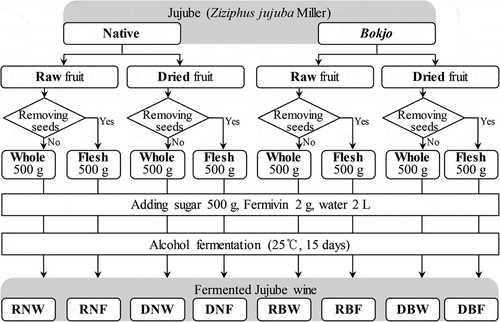
Analysis of physicochemical properties of jujube
The pH and Brix values were measured using a pH meter (D50, Horiba, Kyoto, Japan) and a Brix meter (Pocket PAL1, ATAGO, Tokyo, Japan), respectively. Total acidity was controlled via titration with a 0.1-N NaOH standard solution after adding 4–5 drops of 0.1% phenolphthalein indicator to 10-mL samples. The amount of NaOH solution added was used to calculate tartaric acid in accordance with the following formula: Total acidity in terms of tartaric acid (%) = [(mL NaOH used)×(0.1 N NaOH)×(0.075 milliequivalent factor of tartaric acid)× 100]/mL of the sample. Alcohol content was measured by distillation method. Hundred milliliters of the sample was mixed with 100 mL of distilled water in an Erlenmeyer flask. The Erlenmeyer flask was connected to a distilling apparatus with a cooler, and the solution was distilled to 80 mL. Distilled water was added to the distillate to a total volume of 100 mL, and the alcohol content (%) of the solution was measured with a density meter (DMA 4500A, Anton Paar GmbH, Graz, Austria). The Hunter value was measured by colorimeter. (Spectrophotometer CM-5, Konica Minolta, Tokyo, Japan), and described as L (lightness, 100: white, 0: black), a (redness, +: red, -: green) and b (yellowness, +: yellow, -: blue).
Analysis of volatile compounds
Volatile compounds of jujube wine were analyzed using solid-phase microextraction gas chromatography and mass spectrometry (SPME-GC/MS). The 50/30/30-µm divinylbenzene/carboxen/polydimethylsiloxane (DVB/CAR/PDMS) coated fibers (Supelco, Bellefonte, PA, USA) were used for volatile compound extraction. Each wine sample was transferred to a 20-mL head-space glass vial and tightly capped with a silicon septum and pre-equilibrated for 30 min at 60°C in a thermostatic bath and extracted for 30 min at the same temperature with agitation. Thereafter, the fiber was inserted into the injection port of the GC (250°C) for 1 min to desorb the analytes. A model 7890 GC (Agilent Technology) coupled to a model 5975C quadrople mass spectrometer (Agilent Technology) was used to analyze volatile compounds of jujube wine with a (5%-phenyl)-methylpolysiloxane column (30 m × 0.25 mm × 0.25 μm; HP-5MS, Agilent technology). The temperature of the oven and injector was 250°C. Helium was used as the mobile phase at a constant flow rate of 1.0 mL/min with an oven temperature programmed at 40°C for 20 min, followed by an increase to 150°C at a rate of 3°C/min and finally to 280°C at an increment of 10°C/min, then being maintained at 280°C for 5 min. An Agilent 5975C MSD (ionization voltage, 70 eV; MS source temp., 230°C; MS Quadruple temp., 150°C; MS range: 35 to 350 amu) was used to identify unknown compounds.
Sensory evaluation
Sensory analysis was conducted by nine expert judges from the Korea Food Research Institute. The quantitative descriptive analysis (QDA) method was adopted to assess six properties and four preferences: fruity, grassy, and jujube aroma, sweetness, sourness, bitter taste, appearance, aroma, taste, and overall preference. The judges were instructed to rank the samples in order of appearance, flavor, and taste and to rate the samples on a 9-point scale (0 = weak, and 9 = strong).
Statistical analysis
All results are presented as mean ± standard deviation values. Data regarding physicochemical properties and sensory characteristics of the samples were analyzed using one-way analysis of variance and Duncan’s multiple range tests for post hoc analysis, using SAS package (SAS 9.4, Cary, NC, USA). Multivariate statistical analysis including orthogonal partial least squared discriminate analysis (OPLS-DA) was conducted using SIMCA P+ (ver. 12.0.1, Umetrics, Umea Sweden) to characterize volatile compounds in jujube wine.
Results and discussion
Physicochemical properties
Changes in pH, total acidity, Brix value, and alcohol content of native and Bokjo jujube wines are shown in and . The pH of all eight samples decreased significantly on day 2 of fermentation and subsequently either continuously decreased or remained unchanged depending on the sample. Total acidity in all groups except for DBF increased significantly until day 10 of fermentation. The total acidity in DBF increased significantly until day 4 of fermentation and remained relatively stable. Sugar content (Brix value) on day 1 of fermentation was 19.7–21.2 Brix, which gradually decreased during fermentation. However, on day 2 of fermentation, Brix value of DNW and DNF increased significantly and subsequently decreased. The alcohol content of all samples was 10.9–14.2% at the end of fermentation on the 15th day, and the alcohol content of each group was significantly different (p < 0.01). Interestingly, alcohol content of the fruit flesh group sharply increased during the initial stage and showed a smooth curve afterward, while that of the whole fruit group consistently increased during fermentation. Extraction of ingredients was much easier in the fruit flesh group than in the whole fruit group because the elimination of seeds in the fruit flesh group destroys tissues.[Citation10]
Figure 2. Physicochemical properties, pH (A), total acidity (B), soluble solid (C) and alcohol content (D) of native jujube wine during fermentation. Values are significantly different at p < 0.05 (*) and at p < 0.01 (**) by Duncan’s multiple range test.
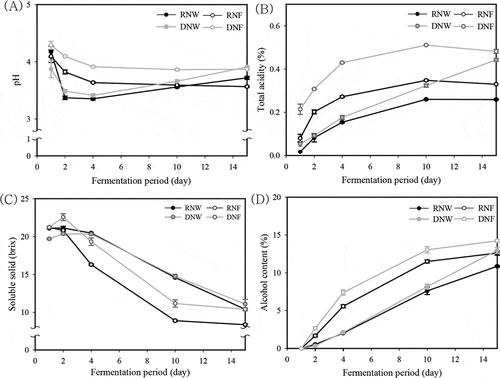
Figure 3. Physicochemical properties, pH (A), total acidity (B), soluble solid (C) and alcohol content (D) of Bokjo jujube wine during fermentation. Values are significantly different at p < 0.05 (*) and at p < 0.01 (**) by Duncan’s multiple range test.
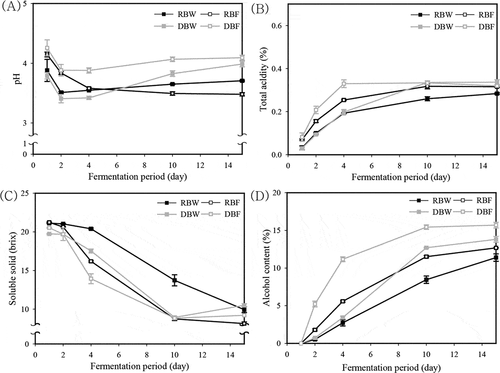
presents the physicochemical properties and Hunter values of jujube wines measured on day 15, the final day of fermentation. The pH of the final products was 3.48–4.09; total acidity, 0.26–0.48%; alcohol content, 10.87–15.70%; Brix value, 8.13–11.10 Brix; L (brightness), 81.5–98.6; a (redness), −2.8–10.1; b (yellowness), 14.8–72.0. The pH and total acidity of dried jujube wine with different contents in previous study [Citation15] were 3.67–3.82 and 0.35–0.40%, respectively, which were similar to the values obtained for the dried jujube group (DNW, DNF, DBW, and DBF) in the current study. However, alcohol content and soluble solid content of the dried jujube wine were 12.50–12.57% and 6.40–6.73 Brix, respectively, which were lower than the values obtained. In addition, in a study on fresh jujube wine [Citation12], the alcohol content of the fresh jujube wine was 10.7–13.0%; total acidity, 0.30%; soluble solid content, 8.7–11.1 Brix; these values were similar to those obtained in the fresh jujube group (RNW, RNF, RBW, and RVF) in this study. Accordingly, differences in alcohol and soluble solid contents of the jujube wine may have resulted from the presence or absence of moisture in the raw material. Overall, the pH, total acidity, a, and b values of jujube wines were higher in the dried jujube group than in the fresh jujube group. Further, alcohol content in the dried jujube group was higher than or similar to that in the fresh jujube group, and the L value in the dried jujube group was lower than that in the fresh jujube group. Thus, the physicochemical properties of jujube wine may be affected by dryness rather than cultivar or presence of seeds.
Table 1. Physicochemical properties and hunter value of jujube wine on the final fifth days.
Sensory properties
The sensory properties of the jujube wine product after 3 months of aging are shown in as a spider map. All properties except for grassy flavor and appearance preference showed significant differences among groups (p < 0.05). shows the correlation between sensory properties and preference. Properties showing positive correlations with overall preference were fruit (R = 0.414, p < 0.05), jujube aroma (R = 0.383, p < 0.01), and sweetness (R = 0.734, p < 0.01); properties negatively correlated with overall preference were grassy aroma (R = -0.189, p < 0.05), sourness (R = -0.231, p < 0.01), and bitter taste (R = -0.375, p < 0.01). Among these properties, fruit aroma and sweetness, which exhibited highly linear relationships, may affect overall preference. Furthermore, although all three preferences were positively correlated with overall preference, taste preference (R = 0.961, p < 0.01) showed the greatest linear relationship. The results indicate that taste has a more significant effect on consumer preference of jujube wines than appearance and aroma, and that consumers prefer jujube wines with higher fruit aroma and sweetness. Interestingly, fruit aroma and sweetness, which positively affects jujube wines, were greater in the whole fruit group (RNW, DNW, RBW, and DBW), whereas negative properties, such as grassy aroma, sourness, and bitter taste, were greater in the fruit flesh group (RNF, DNF, RBF, and DRF) (). In addition, jujube flavor was greater in the wine produced with dried jujube than that with fresh jujube. In a previous study on fermented jujube wine Citation[10], while the jujube flavor was greater in fruit-flesh wine than in whole-fruit wine, sweetness was greater in the whole fruit group, while sourness and bitter taste were greater in the fruit flesh group, concurrent with the present findings. Hence, the sensory properties of jujube wine are determined from the existence of seeds rather than physicochemical properties.
Table 2. Correlation between sensory properties of jujube wine.
Analysis of volatile compounds
Volatile compounds of jujube wine were analyzed via SPME-GC/MS and 43 volatile compounds were identified. To investigate the volatile compound profiles of jujube wine based on the manufacturing method, multivariate analysis was employed for GC-MS spectral data of jujube wines. The volatile compound profile of jujube wine was greatly influenced by the drying process rather than the cultivar and the presence of seeds. Therefore, we generated an OPLS model to determine the effect of the drying process on wine brewing. The OPLS score and loading S-plots of jujube wine based on flavor are presented in and , respectively. In flavor differentiation between dried and fresh jujube wine, the OPLS model () showed high predictability (Q2 = 0.742) and was further validated via the permutation test (), thereby indicating significant differences in several volatile compounds between dried and fresh jujube wines. The significance of the eight volatile compounds marked in red in was confirmed via a pairwise comparison, using a paired t-test (p < 0.05). Jujube wine produced with dried material was characterized by higher isoamyl octanoate, isoamyl decanoate, ethyl laurate, 2-phenylethyl acetate, ethyl myristate, ethyl 9-tetradecenoate, ethyl 9-hexadecenoate and 2-hydroxy-3-cyanopyridine and lower ethyl succinate and ethyl octanoate, compared to that of fresh material, via an OPLS loading S-plot (). The change in flavor compounds in accordance with the drying process of jujube is still unclear. However, based on the current study, fruit, sweet, and nectarous waxy-like compounds, such as isoamyl octanoate, isoamyl decanoate, ethyl laurate, ethyl myristate, and 2-phenethyl acetate, which are known to be the preferred flavor, seem to contribute to the jujube-like flavor of the dried jujube wine. 2-Phenethyl acetate is responsible for apple and honey-like flavor and produced during fermentation of alcoholic beverages and is the ester produced from acetic acid and phenethyl alcohol.[Citation15] Ethyl laurate is responsible for sweet and waxy odor, and isoamyl octanoate, isoamyl decanoate, and ethyl myristate are responsible for pineapple, banana, and sweet fruit odor. Galindo et al., reported that hexanal, trans-2-hexenal, and benzaldehyde were the most abundant compounds in jujube fruits.[Citation16] Interestingly, benzaldehyde, a major component of bitter almond oil, is the most frequently detected volatile compound.[Citation14,Citation16–Citation19] Hence, benzaldehyde levels were higher in the jujube wine produced with dried material than with fresh material. Therefore, benzaldehyde also appears to contribute significantly to the characteristics of bitter and jujube flavor of jujube wine.
Conclusion
The current study aimed to determine the brewing characteristics of jujubes and to compare the characteristics of fresh and dried fruits of the jujube cultivars to provide optimal brewing conditions for jujube wine production. The results show that the physicochemical properties of jujube wine are affected by the drying process rather than by the cultivar or the presence of seeds. The sensory properties, including the aroma and sweetness, which have positive effects on jujube wines, were greater in the whole dried fruit group, whereas negative properties such as grassy aroma, sourness, and bitter taste, were greater in the fresh fruit group, indicating that this result in contrast with the physicochemical properties determined with dried jujube containing seeds. On comparing volatile compounds of jujube wine in accordance with the manufacturing method, significant differences in volatile compounds were identified among the jujube wine samples. In particular, isoamyl octanoate, isoamyl decanoate, ethyl laurate, ethyl myristate, 2-phenethyl acetate, and benzaldehyde appear to contribute to the jujube flavor of the dried jujube wine.
Acknowledgments
This research was funded by the Strategic Initiative for Microbiomes in Agriculture and Food, Ministry of Agriculture, Food and Rural Affairs, Republic of Korea.
References
- Kwon, S.H.; Cho, K.Y.; Kim, S.Y.; Kim, M.J. Application of ZiZiphus Jujube Fruit Dietary Life. Journal of Food Science and Technology 1993, 5, 1–14.
- Choi, S.Y.; Yoon, B.R.; Kim, S.S. Characteristics and Nutritional Composisitons of Two Jujube Varieties Cultivated in Korea. Korean Journal of Food Preservation 2016, 23, 127–130.
- Kim, I.H.; Jeong, C.H.; Park, S.J.; Shim, K.H. Nutritinal Components and Antioxidative Activities of Jujube (Zizyphus Jujuba) Fruit and Leaf. Korean Journal of Food Preservation 2011, 18, 341–348.
- Gao, Q.; Wu, P.; Liu, J.; Wu, C.; Parry, J.; Wang, M. Physico-Chemical Properties and Antioxidant Capacity of Different Jujube (Ziziphus Jujuba Mill.) Cultivars Grown in Loess Plateau of China. Scientia Horticulturae 2011, 130, 62–72.
- Li, J.; Ding, S.; Ding, X. Comparison of Antioxidant Capacities of Extracts from Five Cultivars of Chinese Jujube. Process Biochemistry 2005, 40, 3607–3613.
- Li, J.; Fan, L.; Ding, S.; Ding, X. Nutritional Composition of Five Cultivars of Chinese Jujube. Food Chemistry 2007, 103, 454–460.
- Wojdylo, A.; Figiel, A.; Legua, P.; Lech, K.; Carbonell-Barrachina, A.A.; Hernandez, F. Chemical Composition, Antioxidant Capacity, and Sensory Quality of Dried Jujube Fruits as Affected by Cultivar and Drying Method. Food Chemistry 2016, 207, 170–179.
- Wang, B.; Liu, H.; Zheng, J.; Fan, M.; Cao, W. Distribution of Phenolic Acids in Different Tissues of Jujube and Their Antioxidant Activity. Journal of Agriculture and Food Chemistry 2011, 59, 1288–1292.
- Wang, B.; Huang, Q.; Venkitasamy, C.; Chai, H.; Gao, H.; Cheng, N.; Cao, W.; Lv, X.; Pan, Z. Changes in Phenolic Compounds and Their Antioxidant Capacities in Jujube (Ziziphus Jujuba Miller) during Three Edible Maturity Stages. LWT-Food Science and Technology 2016, 66, 56–62.
- Kim, S.J.; Chun, M.S. The Quality Characteristics of Fermented and Soaked Jujube Wine. Korean Journal of Food and Nutrition 2010, 23, 332–341.
- Min, Y.K.; Lee, M.M.; Jeong, H.S. Fermentation Characteristics of Jujube Alcoholic Beverage from Different Additional Level of Jujube Fruit. Agricultural Chemistry and Biotechnology 1997, 40, 433–437.
- Kang, T.S.; Woo, K.S.; Lee, J.S.; Jeong, H.S. Fermentation Characteristics of Wine Using Fresh Jujube. Food Engineering Progress 2006, 10, 164–171.
- Ji, N.;. Development of Genetic Markers for Identification of Jujube (Ziziphus Jujuba Mill); Chungbuk National University: Cheongju 2016.
- Chun, M.S.; Kim, S.J.; Noh, B.S. Analysis of Free Amino Acids and Flavors in Fermented Jujube Wine by HPLC and GC/MS. Korean Journal of Food Science and Technology 2012, 44, 779–784.
- Li, C.; Sun, J.; Li, T.; Liu, S.; Huang, D. Chemical and Enzymatic Synthesis of Library of 2-Phenethyl Esters and Their Sensory Attributes. Food Chemistry 2014, 154, 205–210.
- Galindo, A.; Noguera-Artiaga, L.; Cruz, Z.; Burló, F.; Hernández, F.; Torrecillas, A.; Carbonell-Barrachina, Á. Sensory and Physico-Chemical Quality Attributes of Jujube Fruits as Affected by Crop Load. LWT-Food Science and Technology 2015, 63, 899–905.
- Wang, H.; Li, P.; Sun, S.; Zhang, Q.; Su, Y.; Zong, Y.; Xie, J. Comparison of Liquid–Liquid Extraction, Simultaneous Distillation Extraction, Ultrasound-Assisted Solvent Extraction, and Headspace Solid-Phase Microextraction for the Determination of Volatile Compounds in Jujube Extract by Gas Chromatography/Mass Spectrometry. Analytical Letters 2014, 47, 654–674.
- Hernandez, F.; Noguera-Artiaga, L.; Burlo, F.; Wojdylo, A.; Carbonell-Barrachina, A.; Legua, P. Physico-Chemical, Nutritional, and Volatile Composition and Sensory Profile of Spanish Jujube (Ziziphus Jujuba Mill.) Fruits. Journal of Science of Food and Agriculture 2016, 96, 2682–2691.
- Lu, Y.; Zhao, Z.; Liu, M. Influences of Drying on the Volatile Compounds in Chinese Jujube. Asian Journal of Chemistry 2013, 25, 3765–3768.

